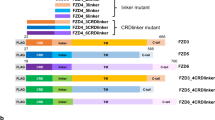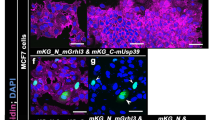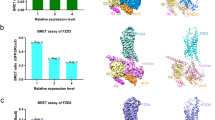Abstract
A seven-transmembrane protein, frizzled, has been implicated in a planar cell polarity (PCP) pathway as well as the canonical Wnt signaling pathway. Although both pathways require a cytoplasmic protein, dishevelled, the molecular mechanism by which frizzled regulates intracellular signaling remains to be elucidated. In the mouse, nine frizzled family members have been identified and six of them contain a PDZ-binding motif at their carboxyl-termini. In this study, we show that a multi-PDZ containing protein, MAGI-3, specifically binds to frizzled-4 and -7. Furthermore, we also demonstrate that MAGI-3 interacts with Ltap, a mouse homolog of the Drosophila PCP protein, stbm, and that these three molecules can form a ternary complex. In epithelial cells, MAGI-3, frizzled-4, and Ltap colocalized at cell contact sites, indicating that these molecules form a physiologically significant complex. Finally, we found that MAGI-3 strongly activated JNK in conjunction with frizzled-4 and Ltap, and that this activation required the small GTPase, Rac. These results indicate that MAGI-3 functions as a scaffold protein for frizzled-4 and Ltap and regulates the JNK signaling cascade.
This is a preview of subscription content, access via your institution
Access options
Subscribe to this journal
Receive 50 print issues and online access
$259.00 per year
only $5.18 per issue
Buy this article
- Purchase on Springer Link
- Instant access to full article PDF
Prices may be subject to local taxes which are calculated during checkout






Similar content being viewed by others
References
Adamsky K, Arnold K, Sabanay H and Peles E . (2003). J. Cell Sci., 116, 1279–1289.
Adler PN . (2002). Dev. Cell, 2, 525–535.
Bhanot P, Brink M, Samos CH, Hsieh JC, Wang Y, Macke JP, Andrew D, Nathans J and Nusse R . (1996). Nature, 382, 225–230.
Boutros M, Paricio N, Strutt DI and Mlodzik M . (1998). Cell, 94, 109–118.
Darken RS, Scola AM, Rakeman AS, Das G, Mlodzik M and Wilson PA . (2002). EMBO J., 21, 976–985.
Dobrosotskaya I, Guy RK and James GL . (1997). J. Biol. Chem., 272, 31589–31597.
Fuchs SY, Fried VA and Ronai Z . (1998). Oncogene, 17, 1483–1490.
Goto T and Keller R . (2002). Dev. Biol., 247, 165–181.
Habas R, Dawid IB and He X . (2003). Genes Dev., 17, 295–309.
Habas R, Kato Y and He X . (2001). Cell, 107, 843–854.
Heisenberg CP, Tada M, Rauch GJ, Saude L, Concha ML, Geisler R, Stemple DL, Smith JC and Wilson SW . (2000). Nature, 405, 76–81.
Hirao K, Hata Y, Ide N, Takeuchi M, Irie M, Yao I, Deguchi M, Toyoda A, Sudhof TC and Takai Y . (1998). J. Biol. Chem., 273, 21105–21110.
Hirao K, Hata Y, Yao I, Deguchi M, Kawabe H, Mizoguchi A and Takai Y . (2000). J. Biol. Chem., 275, 2966–2972.
Ide N, Hata Y, Nishioka H, Hirao K, Yao I, Deguchi M, Mizoguchi A, Nishimori H, Tokino T, Nakamura Y and Takai Y . (1999). Oncogene, 18, 7810–7815.
Ishikawa T, Tamai Y, Zorn AM, Yoshida H, Seldin MF, Nishikawa S and Taketo MM . (2001). Development, 128, 25–33.
Jessen JR, Topczewski J, Bingham S, Sepich DS, Marlow F, Chandrasekhar A and Solnica-Krezel L . (2002). Nat. Cell Biol., 4, 610–615.
Kibar Z, Vogan KJ, Groulx N, Justice MJ, Underhill DA and Gros P . (2001). Nat. Genet., 28, 251–255.
Korinek V, Barker N, Willert K, Molenaar M, Roose J, Wagenaar G, Markman M, Lamers W, Destree O and Clevers H . (1998). Mol. Cell. Biol., 18, 1248–1256.
Molenaar M, van de Wetering M, Oosterwegel M, Peterson-Maduro J, Godsave S, Korinek V, Roose J, Destree O and Clevers H . (1996). Cell, 86, 391–399.
Murdoch JN, Doudney K, Paternotte C, Copp AJ and Stanier P . (2001). Hum. Mol. Genet., 10, 2593–2601.
Nishimura W, Iizuka T, Hirabayashi S, Tanaka N and Hata Y . (2000). J. Cell Physiol., 185, 358–365.
Park M and Moon RT . (2002). Nat. Cell Biol., 4, 20–25.
Robitaille J, MacDonald ML, Kaykas A, Sheldahl LC, Zeisler J, Dube MP, Zhang LH, Singaraja RR, Guernsey DL, Zheng B, Siebert LF, Hoskin-Mott A, Trese MT, Pimstone SN, Shastry BS, Moon RT, Hayden MR, Goldberg YP and Samuels ME . (2002). Nat. Genet., 32, 326–330.
Shiratsuchi T, Futamura M, Oda K, Nishimori H, Nakamura Y and Tokino T . (1998). Biochem. Biophys. Res. Commun., 247, 597–604.
Shoji H, Tsuchida K, Kishi H, Yamakawa N, Matsuzaki T, Liu Z, Nakamura T and Sugino H . (2000). J. Biol. Chem., 275, 5485–5492.
Songyang Z, Fanning AS, Fu C, Xu J, Marfatia SM, Chishti AH, Crompton A, Chan AC, Anderson JM and Cantley LC . (1997). Science, 275, 73–77.
Taylor J, Abramova N, Charlton J and Adler PN . (1998). Genetics, 150, 199–210.
Wallingford JB and Harland RM . (2002). Development, 129, 5815–5825.
Wallingford JB, Rowning BA, Vogeli KM, Rothbacher U, Fraser SE and Harland RM . (2000). Nature, 405, 81–85.
Wang Y, Huso D, Cahill H, Ryugo D and Nathans J . (2001). J. Neurosci., 21, 4761–4771.
Wang Y, Macke JP, Abella BS, Andreasson K, Worley P, Gilbert DJ, Copeland NG, Jenkins NA and Nathans J . (1996). J. Biol. Chem., 271, 4468–4476.
Wang Y, Thekdi N, Smallwood PM, Macke JP and Nathans J . (2002). J. Neurosci., 22, 8563–8573.
Wolff T and Rubin GM . (1998). Development, 125, 1149–1159.
Wood JD, Yuan J, Margolis RL, Colomer V, Duan K, Kushi J, Kaminsky Z, Kleiderlein JJ, Sharp AH and Ross CA . (1998). Mol. Cell. Neurosci., 11, 149–160.
Wu Y, Dowbenko D, Spencer S, Laura R, Lee J, Gu Q and Lasky LA . (2000). J. Biol. Chem., 275, 21477–21485.
Yamanaka H, Moriguchi T, Masuyama N, Kusakabe M, Hanafusa H, Takada R, Takada S and Nishida E . (2002). EMBO Rep., 3, 69–75.
Yao R, Maeda T, Takada S and Noda T . (2001). Biochem. Biophys. Res. Commun., 286, 771–778.
Acknowledgements
We thank Dr E Peles for MAGI-3 cDNA and antibody. We also thank Drs A Hall, J Nathans, T Sudo, Y Kasuya, A Kikuchi, and J Miyazaki for plasmids. This work was supported by a Grant-Aid for Scientific Research from the Ministry on Education, Sports, Science, and Culture of Japan.
Author information
Authors and Affiliations
Corresponding author
Additional information
Supplementary Information accompanies the paper on Oncogene website (http://www.nature.com/onc)
Supplementary information
Rights and permissions
About this article
Cite this article
Yao, R., Natsume, Y. & Noda, T. MAGI-3 is involved in the regulation of the JNK signaling pathway as a scaffold protein for frizzled and Ltap. Oncogene 23, 6023–6030 (2004). https://doi.org/10.1038/sj.onc.1207817
Received:
Revised:
Accepted:
Published:
Issue Date:
DOI: https://doi.org/10.1038/sj.onc.1207817
Keywords
This article is cited by
-
Two Isoforms of the Guanine Nucleotide Exchange Factor, Daple/CCDC88C Cooperate as Tumor Suppressors
Scientific Reports (2019)
-
Involvement of Tight Junction Plaque Proteins in Cancer
Current Pathobiology Reports (2016)
-
MSCA: a spectral comparison algorithm between time series to identify protein-protein interactions
BMC Bioinformatics (2015)
-
Identification of MAGI1 as a tumor-suppressor protein induced by cyclooxygenase-2 inhibitors in colorectal cancer cells
Oncogene (2012)
-
Direct interaction between NHERF1 and Frizzled regulates β-catenin signaling
Oncogene (2011)



